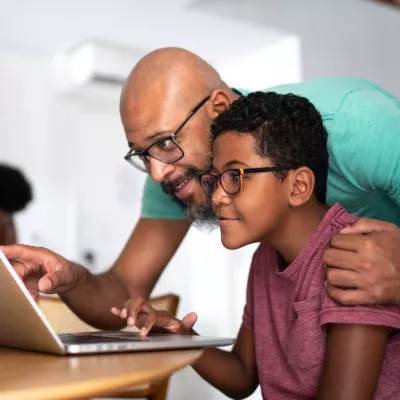- AdventHealth

Staying at home doesn’t have to mean staying sedentary. Getting your heart pumping and blood flowing is important for everyone, at every age, to maintain good heart health.
From toddlers to teenagers, kids should be given plenty of opportunities to burn off energy. Being active has benefits for both physical and emotional health. In addition to being fun, moving around regularly helps kids:
- Boost self-esteem
- Learn better
- Manage their weight
- Reduce stress and anxiety
- Sleep soundly
- Strengthen bones
Here are five ways you can help your child stay healthy (and happy!) with more physical activity.
1. Make Time for an Hour a Day of Play
Children and adolescents need a minimum of 60 minutes of physical activity every day, including activities that make their hearts beat faster, build muscles and strengthen bones. Some ideas for physical activities according to your child’s age include:
Babies younger than age 1: Spend time doing floor-based play several times a day. Ask your pediatrician what’s ideal for your child’s age and ability level.
Children younger than age 5: Children in this age group need up to three hours of play a day. Good options include running around, skipping and jumping — activities that get your little one breathing harder.
Children and teens ages 5 to 17: Kids in this age range should take part in active games and play with family for at least an hour a day. If you’re indoors, online workout classes may be good options for older kids. Younger kids can try hide and seek, jump rope, hopscotch, obstacle courses or games they invent themselves.
2. Be a Role Model
Remember when your little one would follow you around and copy your every move? Kids mimic their parents’ behaviors, so it’s important to make physical activity part of your daily routine and encourage your child to join you. To make sure you stick with it, the Centers for Disease Control and Prevention (CDC) recommends picking enjoyable activities rather than something that sounds like a chore. Dr. Angela Fals from AdventHealth for Children says “When activities are fun and enjoyable- we are more likely to continue exercising long term as our bodies and minds release the “feel good” hormones that come out with physical activity. The more that you do this, the more natural it becomes and the more your body wants to keep being active!”Any exercise that gets the heart pumping is a good choice.
Examples of things you can do togetherwith your child include:
- Bike riding
- Brisk walking
- Jumping rope
- Kicking a ball
- Playing tag
3. Keep It Simple
The days all may seem to run together, but setting a routine and keeping to it will help your child get the daily movement they need. Help your child choose a specific type of activity, time of day to do it and number of minutes to spend on it every day. For example, if walking is going to be part of your family’s physical activity, commit to doing it rain or shine.
You can make physical activity more fun by recording progress on a daily chart and celebrating accomplishments at the end of the week. Also, remember that physical activity doesn’t have to be exercise or sports — house cleaning and lawn care count toward being physically active. Even short breaks from sitting for physical movement, such as walking, stair-climbing or stretching, are beneficial.
4. Reduce Couch Time
Although kids often need quiet time for homework, reading and art, too much sitting or inactivity isn’t healthy. Monitor the time your kids spend watching television, playing video games or using the internet.
Keep in mind that it’s OK to take a more relaxed approach to screen time right now. Recognizing that kids’ screen media use has likely gone up because of stay-at-home recommendations, screen-time guidelines from the American Academy of Pediatrics (AAP)have been suspended. The AAP recommends taking steps to ensure that media use is positive, such as using social media to stay connected with friends and family.
You can lessen screen time by setting up regular family activities like walking the dog, riding bikes together or eating meals at the table as often as you can.
5. Stay Safe While Moving About
Even though many of us still aren’t venturing far from home, we can still do our best to stay fit. In many areas, you and your family can visit parks, trails and open spaces as a way to relieve stress, stay active and get some fresh air and vitamin D. Here’s what you need to know before you and your child go:
Do:
- Visit outdoor areas close to your home
- Check with the park in advance so you know whether bathrooms and water fountains are available and what you need to bring with you
- Stay at least 6 feet away from others
Don’t:
- Use playgrounds or participate in organized activities or sports if local guidelines restrict it
- Visit crowded parks
- Visit if either of you are sick or were recently exposed to COVID-19
Following guidelines from the CDC also will help keep you and your family healthy. This includes washing your hands frequently, using a cloth face mask when outside your home, avoiding close contact with others, cleaning and disinfecting frequently touched surfaces, and covering coughs and sneezes.
Whole-Health Support for the Whole Family



